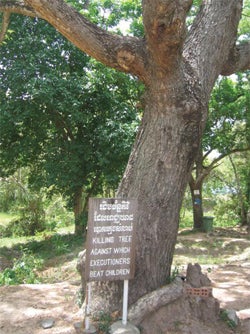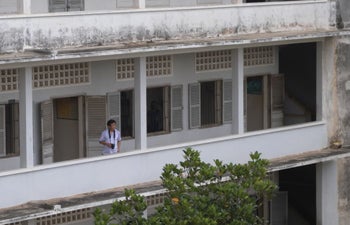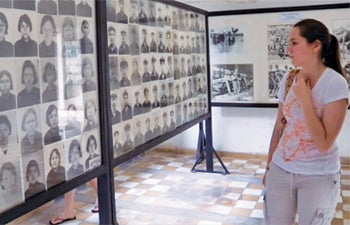Getting to the Roots of Evil
The weary oak carries the burden of a hideous past.
Against its trunk, Khmer Rouge soldiers bashed the delicate skulls of infants and small children, tossing their lifeless bodies into open pits.
As if weeping, a deep crimson stain runs down the oak. It is marked forever as the Killing Tree.
“Prepare yourselves emotionally,” instructor Karen Jungblut advised USC undergraduates before their two-and-a-half-week research trip to Cambodia this past summer.
The eight students participated in USC College’s Problems Without Passports program in Cambodia. During their travels, they studied the 1975 to 1979 genocide in which 2 million Cambodians were killed.
The massacre began when the Khmer Rouge came into power. Led by Pol Pot, followers of the Communist Party of Kampuchea sought to create an agrarian-based society. They moved city-dwellers to the countryside for forced labor. About 21 percent of the country’s population was murdered, or died of starvation, disease and torture.

A wooden sign posted at a large oak at the Choeung Ek killing fields reads: “Killing Tree against which executioners beat children.” Photo credit Julia Mangione.
During the trip, students visited the Choeung Ek killing fields, where some 14,000 men, women and children were bludgeoned or shot to death and left in ditches — one of the nearly 20,000 mass gravesites in Cambodia. A monument, or Buddhist memorial called stupa, contains the skulls of roughly 8,000 victims.
“While walking around the site, I looked down at my feet and saw white and colored things poking out of the ground,” recalled Camille Waddel, an international relations major in the College. “It took me a while to realize that they were bone fragments and clothing remnants of the deceased.”
At the edge of the dirt gravesites stands the massive oak bearing a wooden sign: “Killing Tree against which executioners beat children.”
“It was impossible for me to comprehend,” international relations major Julia Mangione reflected. “I looked at the tree and felt sick to my stomach. You don’t want to believe these things really happen.”
Instructors Kosal Path and Jungblut brought the students to the site so they could more deeply understand the gravity of the crimes. A program goal was to assess whether the United Nations-backed tribunal currently taking place meets Cambodian survivors’ expectations for justice and reconciliation. Thirty-five years after the genocide, some Khmer Rouge regime leaders are being tried for crimes against humanity. Pol Pot died on April 15, 1998, the day the Khmer Rouge agreed to turn him over to an international tribunal. Many believe Pol Pot committed suicide or was poisoned, although the official cause was deemed heart failure.
The first to be tried, Kaing Guek Eav, or “Duch,” commanded the Tuol Sleng S-21 prison where roughly 14,000 people were tortured and sent to their deaths. Found guilty in July, he was sentenced to 35 years in prison, but could be out in 19. Four other top leaders currently face genocide charges.
In summer 2009, the program’s first year, students attended the UN trial, but this time court was not in session. Students, however, visited the court and interviewed Craig Etcheson, a senior analyst in the investigating judges’ office in the tribunal, officially called the Extraordinary Chambers in the Courts of Cambodia (ECCC). Etcheson is also a USC College alumnus, having earned his Ph.D. in international relations in 1985.
During the students’ Etcheson interview, Duch, Nuon Chea, Ieng Sary, Ieng Thirith, and Khieu Samphan were imprisoned in a building 20 yards away.
“It was chilling being so close to such ruthless and heartless murderers,” said Ali Battat, an East Asian languages and cultures, and international relations major. “Just seeing the building where the five are being held confirmed for me that I hope they get what they deserve.”

Kosal Path, lecturer in the College’s School of International Relations, led the program with Karen Jungblut of the USC Shoah Foundation Institute, based in the College. Path, himself a survivor of the Khmer Rouge, stands on a balcony of the Tuol Sleng S-21 prison. Photo credit Karen Jungblut.
When it comes to the perpetrators, however, it’s not always that black and white. During the trip, students interviewed both perpetrators who were not leaders, and victims, and at times the lines blurred between the two groups.
“It was kill or be killed,” Mangione said of the Khmer Rouge soldiers. “I started thinking about how good people could do terrible things.”
Mangione’s final paper titled, “Shades of Gray,” explores that topic. Each student produced a paper as part of the international relations course, “Conflict Resolution and Peace Research in Cambodia.” The course entailed one week of Cambodian history taught by Path, a lecturer in the College’s School of International Relations and himself a survivor of the Khmer Rouge. For the second week, Jungblut, research and documentation director at the USC Shoah Foundation Institute (SFI) for Visual History and Education, taught students how to collect testimonies. During the trip, each student conducted at least one interview.
“Students were engaged,” Jungblut said. “At first, you could see they were nervous and uncomfortable, but they were doing it. They were experiencing collecting testimony from genocide survivors.”
USC College’s Problems Without Passports program sent 10 undergraduates to Cambodia to research the 1975-1979 genocide. Video by Mira Zimet.
The impetus for sending students to Cambodia began with SFI. Headquartered in the College, SFI houses nearly 52,000 video testimonies from Holocaust survivors and witnesses, and is among the world’s largest digital video archives. In spring 2009, three staffers from the Documentation Center of Cambodia (DC-Cam) spent three months at the institute learning more about testimony and interviewing Khmer Rouge survivors in Southern California. DC-Cam is monitoring the tribunal and documenting the Khmer Rouge crimes.
The Cambodia program took off after Path earned his Ph.D. in international relations from the College in 2008 and was ready to teach. Path was one of DC-Cam’s original staff members in the early 1990s.
Born and raised in Prasat, a small Cambodian village, he was not yet 1 year old when the Khmer Rouge seized his homeland. His parents were sent to separate labor camps. Intellectuals were targeted first. His father, a government employee and scholar, concealed his identity passing as a farmer. In the camps, his mother sewed the unisex black uniforms worn by laborers. Path was raised by women villagers too old to work.
In the crowded commune, he remembers fighting for food. A single bowl of porridge containing one fish was all that was placed on a table for the children.
“We all jumped on it and I got the fish,” he recalled. “I remember my cousin next to me crying. I’m sure that was the first time I had ever eaten meat.”
One night, his aunt sneaked into the village to visit young Path. She cradled him, said good-bye and later hanged herself. Rather than be forced to marry a Khmer Rouge soldier responsible for the deaths of several close relatives, she committed suicide.
Path remembers little else of his childhood.
“I lived through this and I don’t remember,” Path said. “I don’t know how I survived.”

USC College lecturer Kosal Path explores the Angkor Wat Hindu temple ruins in the town of Siem Reap in Angkor. Photo credit Julia Mangione.
As a teenager, he began hearing bits and pieces about the Khmer Rouge, a subject not taught in Cambodian high schools. Part of Path’s goal is to educate Cambodian youths about that critical period.
“I knew only that something dark, something terrible had happened to my family from 1975 to 1979,” Path said, adding that he was reunited with his parents in 1979.
It wasn’t until Path was an undergraduate in Phnom Penh, Cambodia, when he learned the extent of the atrocities committed against his family. In the 1990s, as a translator and researcher in Yale University’s Cambodian Genocide Program and then in DC-Cam, he began to fully grasp the brutality of the Khmer Rouge regime.
For his master’s thesis as a USC College graduate student, Path analyzed the politics of bringing the Khmer Rouge to justice. He took courses from Steve Lamy, vice dean for academic programs in the College. He was also a teaching assistant for Lamy, professor of international relations and former director of its school.
“I saw Kosal as an ideal choice for Problems Without Passports,” said Lamy, who created the program that takes students from Belize to Zacatecas, Mexico. “I know he loves teaching and really cares for his students. He’s from Cambodia, survived this period and knows a great deal about the issues and the region.”
Understanding the underpinnings of genocide is crucial for all ethnicities.
“Genocide belongs to humanity,” Path said. “Not one group of people. The current generation does not fully comprehend what happened in Cambodia. So it could happen again. It could explode at any time.”
At the Choeung Ek killing fields, Kosal opened up to students about his own experiences.
“Perhaps he was moved by all of our emotions and the somberness of it all, but Professor Path told us for the first time, really, about his family and his origins,” Battat said. “It was really touching to hear him talk about that part of his life.”
The same day, students visited the Tuol Sleng S-21 prison, where only about a dozen captives survived. They walked through rooms exhibiting photographs of prisoners — men, women and children, and mothers holding babies — all wearing mandatory uniforms, with numbered boards hanging from strings around their necks.
“Some look slightly away from the camera,” Battat said of the photographed prisoners. “Some look at the camera with absolute fear and hopelessness. Others hold their heads high and steady with a firm gaze.”

International relations major Julia Mangione examines photos of victims at the Tuol Sleng S-21 prison’s genocide museum. Of roughly 14,000 imprisioned, only about 12 survived. Photo credit Karen Jungblut.
Most photographed were sent immediately to the killing fields. Prisoners considered important were tortured until they confessed, then sent to be executed. The prison was an old high school and the Khmer Rouge used former exercise equipment to aid in waterboarding, electrification and hanging. A list of posted prison rules included: “While getting lashes or electrification you must not cry.”
“S-21 is horrifying,” Battat said. “It’s eerie, it’s disturbing and it’s shocking. It’s every emotion that will twist your stomach and make you want to curl up in a ball and cover your eyes and ears because it doesn’t seem like it could have been possible.”
They walked through cells where cots still had chains and torture devices in place.
“The cells didn’t even seem like a humane amount of living space for a small animal, much less for a human being,” Waddel said.
Students did extensive research before interviewing. They met with officials at DC-Cam and the Center for Justice and Reconciliation, an NGO that reaches out to Cambodian victims and perpetrators. They met with the Cambodian Human Rights Action Committee, another NGO working closely with the ECCC to encourage survivors to come forward. They also met with top officials at the U.S. Embassy and >> Cambodia’s secretary of state of foreign affairs.
During their interviews, students learned that many victims live near their families’ killers in the small villages. One survivor was Chut So, whose neighbor, Hun Kin, is a former S-21 soldier responsible for the death of her husband, Thurn. She often runs into Kin, who admits leading Thurn, who had lost a leg fighting the Khmer Rouge and walked with a crutch, to the killing fields. Thurn was beaten to death with a hoe. Still mourning her husband’s death, So continues to display her grief by shaving her white hair nearly to the scalp and wearing only a collarless slate shirt and baggy slate pants.
A video of the interview, conducted by sociology major Shoshana Polansky, shows them sitting on the ground in a circle with So’s daughter, Leng, and an interpreter near a pagoda where Buddhists worship. While telling her story, So is chewing a betel leaf and swatting flies swarming around her infected toe. Boy monks wearing tangerine robes listen intently in the background.
“Is it true you went to find your husband’s remains?” Polansky asks.
“We found that his skull and bones had been cracked,” So replies through an interpreter. “We knew how he was killed, then we gave him a proper burial.”
“When you see your neighbor, Kin, how do you interact with him?” Polansky asks.
“The anger before was worse than now; I try to ignore him,” So replies. “But it is hard to see him. Something in my heart always reminds me that he is the man who killed my husband.”
“Can you ever forgive the perpetrators?” Polansky asks.
“Maybe if he asked for an apology, I might forgive him,” So says of Kin. “But no one has asked for an apology.”
So recalls that her eldest son sought revenge. But on his way to Kin’s home to kill him, the son fell into a well.
“Now I leave the judging to God,” So says. “I don’t want to continue the pain and bloodshed. If I allowed my children to seek revenge, the conflict would continue. I want it to end. I leave it to karma.”
Cambodians’ belief in karma was examined in Battat’s final paper. In Cambodia, 96 percent of residents are Buddhists. Battat found that many Cambodians are ambivalent about the ongoing trials and subsequent punishments. Their religion professes that people who commit evil deeds will be punished in their next life.
Even So’s son took his toppling into a well as a sign and decided to follow the Buddhist practice of letting go. But letting go is difficult when survivors still yearn to know what happened to their loved ones.
“Dialogue will hopefully present the truth and allow for closure,” Battat said of achieving forgiveness and reconciliation in the country.
With the current trials, dialogue is emerging for the first time.

USC College students collect testimonies from Khmer Rouge genocide survivors inside a pagoda place of worship in the Krang Tachan village in Takeo province, Cambodia. Photo creadit Karen Jungblut.
Interviews of victims and perpetrators are forcing residents to broach the subject. To help illustrate the gray zone, a concept first introduced by Holocaust survivor Primo Levi, Mangione notes a DC-Cam interview of Kin, who was a teenage soldier when he led Thurn to his death.
“Why do you think the Khmer Rouge killed and starved people?” DC-Cam asks.
“I never would have believed what happened in my generation,” Kin replies. “We people just could not stand firm to our own position. It was not the foreigners, but Khmer who killed Khmer. I did understand that it was totally wrong to do so. But if I didn’t do as I was told, I would be punished. I just followed the assignment.”
“Do you feel regret for what you have done?” DC-Cam asks.
“Yes, I do. I feel pity for those I killed,” Kin replies. “At that time, I was too innocent and followed every assignment of the Khmer Rouge.”
Then Mangione herself interviewed a former S-21 prison guard, Kung Phai, who said he was 16 when he joined the Khmer Rouge. His superior was Duch.
“I just followed orders,” Phai says.
“Did you ever resist an order?” Mangione asks.
“No,” Phai replies.
“What would have happened if you resisted an order?” Mangione asks.
“Death,” Phai responds.
“Did you ever consider dying rather than following the orders?” Mangione asks. But the DC-Cam interpreter won’t relay the question to Phai, saying it may be too insulting.

Ali Battat, an East Asian languages and cultures, and international relations major, holds hands with a woman she affectionately nicknamed Grandma at a village in the Takeo province. The woman lost all of her nine children during the Khmer Rouge regime. Photo credit Kosal Path.
While students interviewed a schoolteacher who lost 40 family members to the Khmer Rouge, including her father, an elderly Cambodian woman sat quietly in the circle.
“She kept smiling at me and at one point took my hand in hers and held it tight,” Battat said. “It was a very sweet gesture and the look in her eyes was of pure compassion.”
The schoolteacher didn’t hide her anger, admitting that she shows prejudice against her students who are related to former Khmer Rouge soldiers. The elderly woman listened silently. Later, the students learned that the woman had lost all nine of her children to the Khmer Rouge.
“Knowing what she’s been through, what she’s lost, her warm smile and comforting touch meant so much more,” Battat said. Before leaving, Battat asked Path to take their photo.
“Again, she held my hand as she stood next to me, smiling and complimenting me in Khmer,” Battat said. “Professor Path, as he took the picture, kept saying ‘picture with Grandma, Grandma with granddaughter.’ Perhaps I was her granddaughter for that moment.”
Read more articles from USC College Magazine’s Fall 2010/Winter 2011 issue